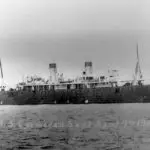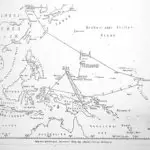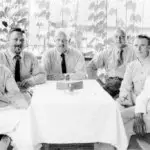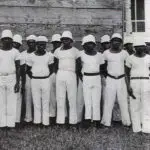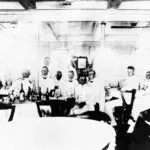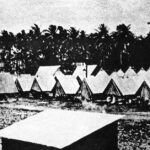SMS Cormoran II
Table of Contents
Share This
100th Anniversary of the Arrival of SMS Cormoran II in Guam
Alongside the busy traffic on Marine Corps Drive in East Hagåtña, there is a small cemetery, oddly placed between Padre Palomo Park and a car dealership, its gravestones lined neatly in parallel rows on closely trimmed grass. Located in “Row K,” close to the beach which looks out to the Philippine Sea, there is a small obelisk with a carved image of a German iron cross on one side. Below the cross, the obelisk is inscribed with words in German: “Die Toten von SMS Cormoran“—”the Dead of the SMS Cormoran”—7 April 1917.
About 11 miles south at Apra Harbor lie the remains of a German cruiser, scuttled by its crew on 7 April 1917. Although accounts of the scuttling vary, at least seven Germans were killed during the explosion, the earliest casualties as newly declared enemies of the United States in World War I.
The Cormoran had arrived on the US territory of Guam just three years earlier; its crew, though interned, was treated with hospitality and friendship by military personnel and island residents despite strained relations between the US and Germany. In what was a unique opportunity for cultural encounter and exchange, the largely German crew of over 350 also included individuals from China and German New Guinea, all of whom were able to interact on shore. However, the Naval governor of Guam had refused to give the Cormoran’s captain, Adalbert Zuckschwerdt, any of the limited coal supply available on the island that would allow them to leave, and so the Cormoran’s crew remained in Guam, taking in the warmth of island life for two and a half years until the US formally entered the First World War.
On 14 December 2014 marked the 100th Anniversary of the arrival of the SMS Cormoran II in Guam. With a grant from the Guam Council on the Arts and Humanities Agency (CAHA) Guampedia developed a new collection of entries based on the arrival of the Cormoran, along with stories and images of its stay in Guam. The entries represent some of the research in preparation for a virtual exhibit about the Cormoran for Guampedia. The story of the Cormoran’s arrival in Guam is compelling because it offers a glimpse into Guam’s history at a period of transition and change, and a time when the island would once again be caught up in world events.
The Cormoran’s wreck site in the waters of Apra Harbor is also of interest historically because it lies with a Japanese vessel, the Tokai Maru, which was sunk during World War II. Resting over 110 feet under water, this is the only site where two vessels from two different world wars can be seen lying side by side. Indeed, the site is registered with the National Register of Historic Places.
While most people are familiar with the general story of the Cormoran’s arrival and eventual destruction, few are aware of the other details of the Cormoran and the activities of the crew while interned in Guam. This new set of entries will provide some of the interesting and compelling stories of the ship, the interactions of the crew with the local population, the Chamorro descendants of at least one Cormoran crew member, and some insights into the place of Guam’s history in the larger story of US-German-Chamorro relations, World War I, and the impacts of the encounter on the culture and society in Guam.
Tracing Cormoran’s journey
The story of the Cormoran’s arrival in Guam actually goes back to Qingdao (Tsingtao), China, where the original SMS Cormoran, a light cruiser, had participated in the occupation of the harbor there to establish a German colony in Asia. Built in 1893, the Cormoran also was engaged in German activities in Samoa in 1900 and the suppression of rebellions in Pohnpei in 1910 and 1911. In 1912, the Cormoran was converted into a gunboat, and the vessel traveled from China to Sydney in 1913. Captain Adalbert Zuckschwerdt, an artillery officer from Worbis, Germany, took command of the ship at this time. Its last voyage was in September 1913 when the Cormoran stopped in Guam for a five-day stay, giving the crew the chance to relax and enjoy the hospitality of the island and its people.
Back at Tsingtao with the outbreak of World War I in August 1914, it became clear that the port would become a main target for allied Japanese and British navies in the Pacific. As the Cormoran was hurriedly outfitted and prepared for war, the ship’s engine was accidentally destroyed. Another German ship, the Emden, had captured the German-made, Russian operated merchant ship Rjasan and brought the vessel back to Tsingtao. The Cormoran was dismantled and its guns, supplies, crew and name were transferred to the captured vessel, now known as the SMS Cormoran II. Captain Zuckschwerdt took the helm and with his hastily trained men, left Tsingtao and headed toward the Marshall Islands to join the German naval fleet under the command of Admiral Maxilmillian Von Spee.
After weathering a typhoon and running low on fuel, the Comoran II arrived at Majuro, and received orders to continue on as an independent war cruiser in Australian waters to confuse the enemy. The Cormoran, however, was not an effective warship, and its reliance on coal made it vulnerable to running out of fuel if it could not find a suitable place to refuel while keeping its location secret. Soon, the hunter became the hunted and the Cormoran found itself in a race for cover, evading capture from Japanese warships while traveling back and forth from the Solomons to German New Guinea and the Carolines. Finally, after two months of movement through the South Pacific, the Comoran reached Guam in the evening hours of 13 December 1914.
The Cormoran in Guam
The Cormoran moved into Apra Harbor the following morning, weatherbeaten and worn, hardly looking like a threat to the island’s contingent of some 400 Marines. Captain Zuckschwerdt, disregarding much of the expected military protocol and decorum, visited Naval Governor William J. Maxwell to request enough coal to depart Guam and 30-days provisions for his crew. Maxwell, however, stated he could not provide the requested items, as the island’s supply of coal was limited and the provisions would greatly cut into the needs of the local population. The governor instead gave the Cormoran captain the option of leaving Guam within 24 hours, or of interning his ship for the duration of the hostilities. When the 24-hour period had passed, the governor ordered the Cormoran and its crew interned in Guam.
Captain Zuckschwerdt, unhappy about the situation, understood Maxwell’s rationale, and hoped the internment would not be long. Maxwell’s conditions included the disarmament of the ship and that the crew would remain quartered there. They would not go beyond a determined boundary line when on shore. Because of the unpredictable weather, Maxwell agreed the ship’s machinery would remain operable. Two hundred tons of coal would be kept onboard in case the ship would have to be taken out to open sea. In spite of the agreement, Zuckschwerdt and Maxwell had a very tense relationship and had their own personal war with each other over funds, supplies and control.
In 1916, Maxwell was replaced temporarily by Lt. Comdr. William O. Cronan of the USS Supply, who ordered the complete disarmament of the Cormoran, but also demanded that the Germans be treated as friendly guests and allowed for greater social interaction with the people of Guam. The relationship between the Cormoran crew and the island residents became more pleasant, as the long internment onboard had been especially trying for the Germans. With the new permitted exchanges and freedom, the crew socialized more, especially with local women and several romantic interludes and marriages between Germans and Chamorros took place.
However, while relations with the Germans in Guam were pleasant, elevating political tensions between the governments of the United States and Germany were of grave concern to Zuckschwerdt and the newly appointed governor, Captain Roy C. Smith. By early 1917, Smith had heard rumors of the Cormoran’s crew hoarding coal, and he wrote to Zuckschwerdt requesting he be allowed to inspect the ship. Zuckschwerdt refused at first but eventually relented. Unbeknownst to the Americans, the Cormoran had remained armed and a stash of coal hidden onboard. The following weeks were filled with tension as both sides prepared for war. Zuckschwerdt, faced with the decision to attack the garrison in Guam, or scuttle the ship, chose the latter though less honorable wartime route, and therefore avoid the needless sacrifice of lives. With a demolition charge in place that had been concealed the entire time on the Cormoran, the crew prepared to scuttle the vessel and practiced abandon ship drills. The code word for the scuttling of the ship would be “Cormoran.”
The journey ends
On 7 April, Governor Smith received the cablegram that the US had declared war on Germany. Captain Zuckschwerdt was ordered to surrender the vessel over to the Americans. Zuckschwerdt replied he would turn over himself and his crew, but he could not turn over the ship. He ordered the crew to abandon ship, with the sick and non-swimmers boarding the sole lifeboat. An explosion followed and within minutes, the Cormoran sank. The Americans hurriedly rescued the Germans, using the Supply as a hospital boat. A marine sentry aimed his rifle to shoot at the Germans when another marine pushed the rifle so that the shot fired harmlessly into the air. This was the first and only hostile and violent encounter between German and US military forces in the Pacific for the duration of the war.
It was reported later by the US Navy that seven Germans had been killed. They were buried with full military honors and a marker erected at the Naval Cemetery in Hagåtña. The rest of the crew were taken as prisoners of war and sent to various forts in the US until they were released at the end of the war in 1919.
Remembering the Cormoran
Unmistakably, one of the most important periods in Guam history is World War II. In the decades since the war ended memorials have been built, Masses offered, parades and pageants organized, as well as documentary films and books produced to record, commemorate, honor and remind us of the experiences of the Chamorro people. We retell their stories of survival, the tragedy and atrocities of foreign occupation, as well as remember the people who valiantly fought over this island according to their governments’ directives. In stark contrast, in that small cemetery in Hagåtña lies one of the few reminders of the First World War, a short white obelisk inscribed with the name of a ship which, for a brief moment in time, touched Guam’s shores and now remains beneath her cool blue waters.
In July 1974, the SMS Cormoran II was listed on the Guam Register of Historic Places, and a year later, the vessel was listed on the National Register of Historic Places. The National Park Service surveyed the site in 1983, and the area remains a popular dive site for locals and visitors alike.
In April 2007, Guam commemorated the 90th anniversary of the scuttling of the SMS Cormoran II. The festivities included wreath-laying ceremonies at Apra Harbor and the US Naval Cemetery in Hagåtña, and a series of lectures and an exhibit. Surviving descendants of the original crew and other German representatives were invited to participate. Hosted by the Guam Visitors Bureau and the Department of Parks and Recreation, the week-long celebration was just one way to remember and celebrate the Cormoran and its crew.
In this section of Guampedia the story of the Cormoran’s historic journey is retold and shared with a global audience, introducing the major figures related to this story, and the impact of the Cormoran’s presence and its crew on the people of Guam. This section not only sheds light on an interesting part of Guam history but also open the door for new research on the island’s maritime history, the German presence in the Mariana Islands and the genealogy of German-descended families in Guam. We have already been able to discern the history of two German families believed to have ties to the Cormoran, and connected with Cormoran descendants in the United States and Germany, including Dorit Mathers (daughter of Ernest Max Adolf) and Elisabeth Heim (granddaughter of Emil Bischoff), who have provided us with valuable resources and information.
This project also is possible through the assistance of local historians Dr. Lawrence Cunningham and Toni Ramirez from the Department of Parks and Recreation, James Oelke-Farley, and the kind folks at the Micronesia Area Research Center at the University of Guam who let us rummage through their amazing collections.
If you have information about the Cormoran or its crew that you would like to share please contact Guampedia.
SMS Cormoran entries
- Captain Adalbert Zuckschwerdt
- Cormoran-Südseefahrer: SMS Cormoran Crew Annual Meetings
- Governor William John Maxwell
- SMS Cormoran I
- SMS Cormoran II
- SMS Cormoran II Memorial
- SMS Cormoran II: Local Stories
- SMS Cormoran II: Non-German Crew Members
- SMS Cormoran II: Partial Crew List
- SMS Cormoran II: Two Crew Member Profiles
- The Journey of SMS Cormoran II
- The SMS Cormoran II Crew – Prisoners of War
- SMS Cormoran: 90th Anniversary
Videos
For further reading
Bartlett, Owen. “Destruction of S.M.S. “Cormoran”.” US Naval Institute Proceedings 57, no. 342 (August 1931): 1044-1051.
Burdick, Charles. The Frustrated Raider. Carbondale: Southern Illinois University Press, 1979.
Forbes, Eric. “Today in History: German Ship Blows Up in Apra Harbor April 7, 1917.” paleric, 7 April 2012.
McFadyen, Michael. “SMS Cormoran.” Michael McFadyen’s Scuba Diving Web Site.
Ward, Herbert T. The Flight of the Cormoran. New York: Vantage Press, 1970.

